The impassion of the brutal era - Francis Bacon and his box
the impassion of the brutal era – Francis bacon and his box "I feel ever so strongly that an artist must be nourished by his passions and his despairs. These things alter an artist whether for the good or the better or the worse." —Francis
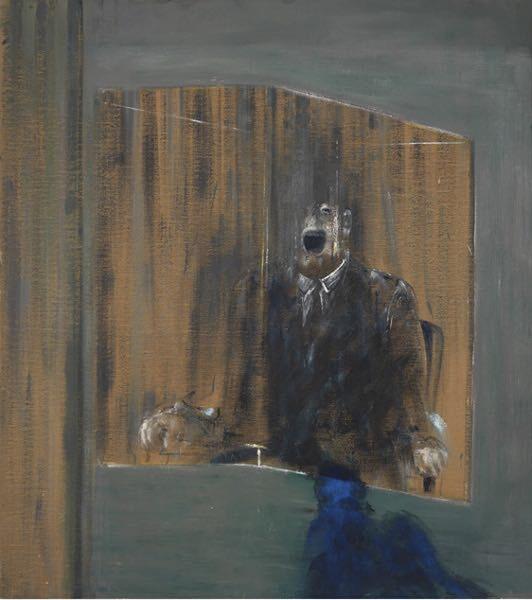
Bacon Artist Francis Bacon is best known for his post-World War II paintinFrancis Bacon (28 October 1909 – 28 April 1992) was an Irish-born British figurative painter known for his bold, , emotionally charged and raw imagery. As a young man, he grotesque settled in London and began a career as a self-taught artist. Most of his paintings from the 1940s to 1960s depict the human figure in scenes that suggest alienation, violence and suffering. Bacon's provocative, expressive work is considered some of the most important art of the postwar era. Bacon every time will focus on a theme, which includes the series of victims, the Pope series, as well as the later single and triple head portrait. In the following, we will analyze the different ways of displaying the boxes in each series. Bacon was a bon vivant and gambler who took up painting in his early 20s. He admitted that his artistic career was delayed because he spent too long looking for subject matter that could sustain his interest. His breakthrough came in the 1940s. ‘Study of portrait’ (1949) is Bacon's early art work. In the middle of the painting, we can see a man in a suit, is sitting on a chair. He is trapped in an orange abstract box. In the gray background, the orange box looks more prominent. If we look more carefully, we can find that he grows his mouth, his hands are tied on the chair. He is screaming and praying for relief. The fact that the man's face can not be seen is very clear,on the contrary, Bacon used strokes to make the man's face look more ferocious. The strong psychological activities of the character makes the whole atmosphere become creepier, the whole work reflects a strong resistant will. We start to think who is this man sitting there?Bacon has not explained it. Perhaps a man who sees through his mediocre evil. Realizing that you are never able to escape to become the slaves of capitalism. The pain in the painting is linked to the artist's own personal experience. At 16 years old Bacon found his homosexuality, his father exiled him to live in London. Before he was 30 years old, he had experienced a turbulent Irish independence movement. After that, during the low ebb of Bacon's life, he suffered two World Wars which nearly destroyed London. These resulting merciless style was showed in his paitning. Also the ‘box’ painting elements continued into his later art works .
‘Study after Velazquez’s portrait of pope innocent X’(1953) is recreated form ‘Portrait of Innocent X(1650). similar to the previous painting, the figure is also bound in a chair which is symbolic of power. Comtrasting with the original painting, we can find Bacon made the original red clothes and the background change to purple clothes and dark black background. In addistion , there re many yellow geometric frameworkds around the screaming man. This yellow box surrounded him like a prison set up virtually. The colour contrast bettwen the black and yellow make the painting looks more dramatic.Since Bacon’s paintings were frequently commentaries on the human condition, you, the observer, are brought into the paintings, close enough to smell the mortality. As Bacon himself said.
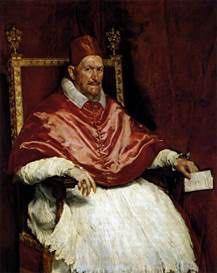
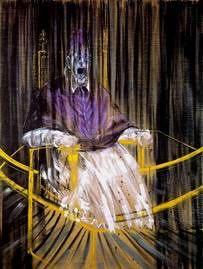
‘Three Figures in a Room' (1964) and Three Studies of Lucian Freud (1969) are the roots of the painting of George Dyer. Whom Bacon first met in 1963. It is the first of Bacon's works to feature Dyer.The work has been described as Bacon's first secular triptych.
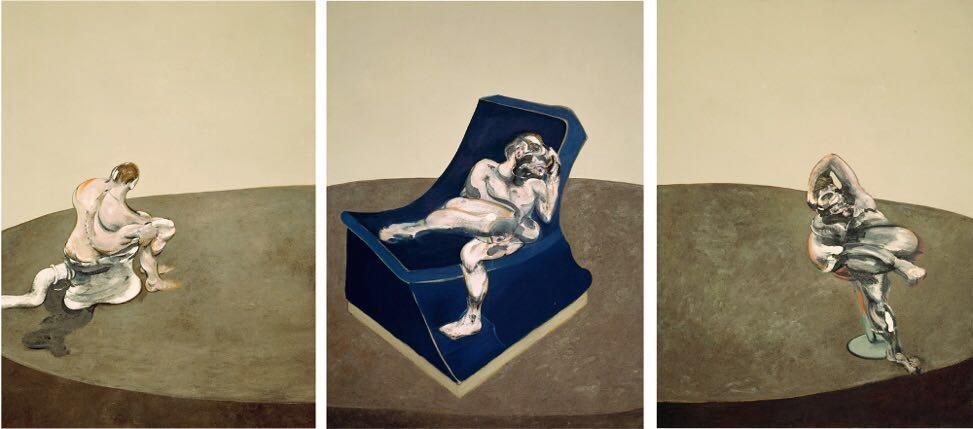
Firstly, we can see Dyer is is prepared in three different positions, all twisted and contorted. Bacon uses large and vigorous brushstrokes to create distinctive splashes of color. In the left panel, a naked Dyer sits on a toilet facing away. In the middle of the portrait, the twisted dyer lies in a huge blue - black box, one leg in the box, the other leg on the outside, it is very weak. The third is of Dyer cross-legged sitting in an orange. Art critic Dacid Sylvester has suggested that the center and right figures may be inspired by Michelangeol’s sculptures in the Medici Chapel, and drwas parallels with the three figures in Henri Matisse’s Bathers with a Turtle.(1908)In contrast, we can feel that the two artists have a wild brush on the nude painting of the characters.
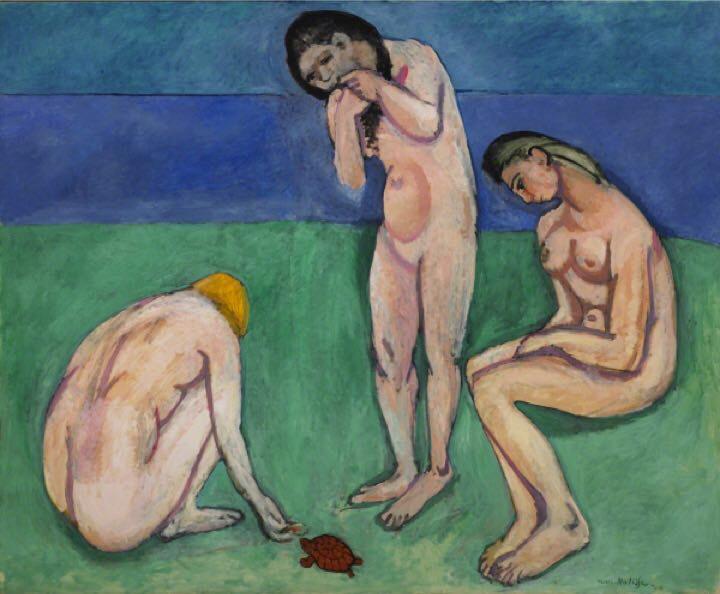
‘Three Lucian Freud’ (1969) also a study of dyer, All three panels, in Bacon's classic abstract, distorted, isolated style. In fact, the colour is brighter than is typical of Bacon's works. The painting shows Freud sitting on a cane-bottomed wooden chair within a cage, on a curved mottled-brown surface with a solid orange background. Michael Peppiatt writes "Trapped here in a series of Baconian cages, a contorted Freud hovers from panel to panel like a coiled spring about to shoot out of the flat, airless picture plane. "

In fact, we can find that the box in the two triple painting in the form of expression is very different, in the first, the box was more figurative, and the second piece of the box looks more geometry. It wrapped in the characters behind everything, also thought that imprisoned everything.

In Bacon's later works, he is more focused on the characterization of sand. In ‘Sand Dune’(1983), the red background and the blue inside the box ,the contrast of which highlights a different sense of space. It is sand, but of course not only sand. It is also flesh, a pure flesh. This flesh has no rigidity, no internal structure, no tension, no action. It is simply a contour of skin, containing soft blob. It lies in itself, it has sinkings and swellings, it rolls in indolence, melding into a single flow. It is like pure flesh but it also has hints of a creature within it too. An anatomy exists, just about. There are buttocks rising, a bending left knee sticks out at the front, a right thigh is stretched out, even a shoulder and an elbow become visible. As you look more carefully, this figure appears, face down, concise like mounds from the sand, like somebody covered in sand, or made loosely from sand. ‘Sand Dune’ is in metamorphosis, in a calm hysteria. In bacin’s book ,the logic of sensation ,French philosper gilles deleuze said.
On April 28, 1992,bacon died in Madrid, Spain,we can see in the works of Bacon, the elements of the box are repeated, whether it is a character or a clay, and they seem to be kept in a transparent, confined space. In One of Bacon's favorite books - Nietzsche's the brith of tragedy. One sentence form this book has explains Bacon’s whole life’s work. ‘art is not merely imitation of the reality of nature but rather a metaphysical supplement of reality of nature, placed beside it for its ’ His art work truly records the people’s life in twenty the twemtieth century. He lived through the revolutionary Irish movement, Sinn Fein, and the world wars, Hiroshima, Hitler, the death camps, and daily violence that he has experienced all his life. His paintings reveal to people the pain of existence, and the poor and horrifying side of human nature.